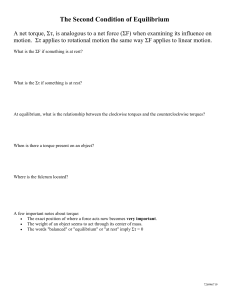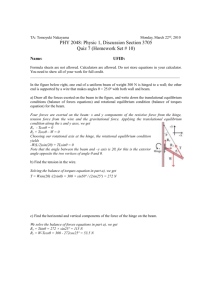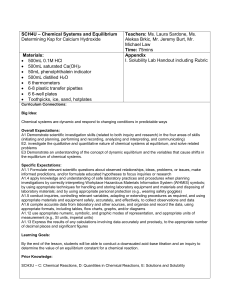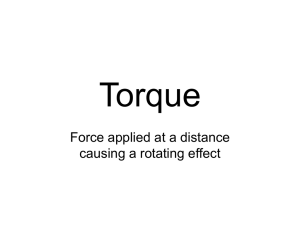physics 220 lab #7: static equilibrium
advertisement
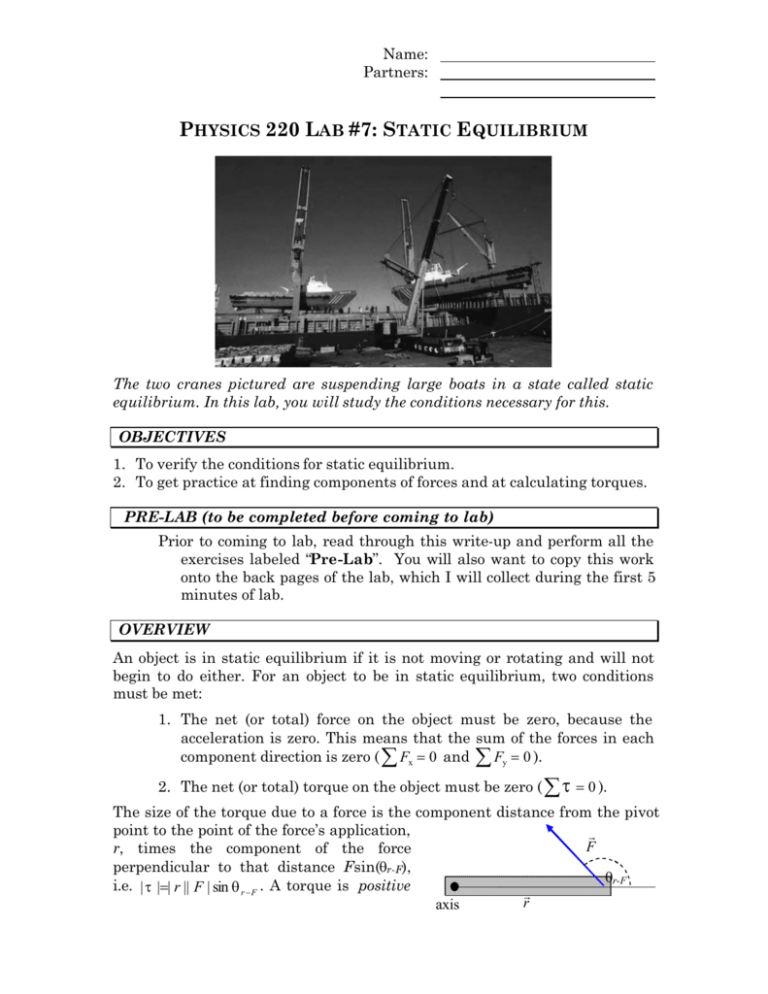
Name: Partners: PHYSICS 220 LAB #7: STATIC E QUILIBRIUM The two cranes pictured are suspending large boats in a state called static equilibrium. In this lab, you will study the conditions necessary for this. OBJECTIVES 1. To verify the conditions for static equilibrium. 2. To get practice at finding components of forces and at calculating torques. PRE-LAB (to be completed before coming to lab) Prior to coming to lab, read through this write-up and perform all the exercises labeled “Pre-Lab”. You will also want to copy this work onto the back pages of the lab, which I will collect during the first 5 minutes of lab. OVERVIEW An object is in static equilibrium if it is not moving or rotating and will not begin to do either. For an object to be in static equilibrium, two conditions must be met: 1. The net (or total) force on the object must be zero, because the acceleration is zero. This means that the sum of the forces in each component direction is zero ( ∑ Fx = 0 and ∑ Fy = 0 ). 2. The net (or total) torque on the object must be zero ( ∑ τ = 0 ). The size of the torque due to a force is the component distance from the pivot point to the point of the force’s application, r F r, times the component of the force perpendicular to that distance Fsin(θr-F), θr-F i.e. | τ |=| r || F | sin θ r − F . A torque is positive r r axis if the force by itself would cause the object to start rotating counterclockwise. It is negative if it would cause clockwise rotation. PART ONE: The Force Table 1. Carefully level the force table. Hang 200 grams from one string and 300 grams from another. Place these strings at an angle other than 90°. 2. Adjust the mass hanging from the third string and its angle so that the ring does not touch the pin in the middle of the table pin (then the three tensions alone keep the ring in equilibrium) and each string points directly toward the pin (so the angles can be measured accurately). 3. Record the masses and angles below. Don’t forget to include the mass of the hanger if you use one. m1 = kg θ1 = ° m2 = kg θ2 = ° m3 = kg θ3 = ° Pre-Lab: Draw a free-body diagram for one of the masses below. How is the tension of the string related to the mass? Explain. 4. Assume the tensions on the ring are approximately horizontal (of course, they must actually be slightly upward to hold up the ring). On the following grid, carefully draw and label the horizontal forces on the ring (sizes and angles) as seen from above. Use the x-axis as Page 2 Physics 220 Lab #7: Static Equilibrium 0°. The lengths of the vectors should approximately represent the relative sizes of the forces. 90° y 180° 0° x 270° 5. By adding the components of the individual forces, find the net measured force on the ring. Show all of your work clearly (Label things, don’t just write down a bunch of numbers!). Page 3 Physics 220 Lab #7: Static Equilibrium Question: How does the net force compare to what you expect it to be? Explain. (No need to calculate percent errors.) Before continuing: Check with your instructor. PART TWO: The Crane 1. Measure the length of the beam. Use the spring scale to measure the weigh of the beam. Note that it reads in grams, you’ll want to convert that to Newton’s. L= m W= N 2. Set up the stand clamps, string, beam, and force probe as shown below. Hang a 500-gram mass by a string from the end of the beam. hook Spring Scale θ1 θ2 beam clamp 3. Measure the angles between the beam and each of the strings. θ1 = ° θ2 = ° 4. Use the spring scale to measure the tension on the string. T= Page 4 N Physics 220 Lab #7: Static Equilibrium 5. Pre-Lab: Carefully sketch the beam and all of the forces on it. Be sure to indicate where the forces act and their directions. (Recall that the beam’s own weight can be thought of as acting at its center of mass.) Questions: What force on the beam haven’t you measured? Where does it act? 6. Use the location of the unknown force as the axis of rotation, i.e. the pivot point. Label the pivot point in the diagram below step 5. Page 5 Physics 220 Lab #7: Static Equilibrium 7. Using counterclockwise as the positive direction for torque, find the net measured torque about the pivot point. Show all of your work clearly. Question: How does the net torque compare to what you expect it to be? Explain. (No need to calculate percent errors.) Before Continuing: Check with your instructor. Page 6 Physics 220 Lab #7: Static Equilibrium 8. Determine the horizontal and vertical components of the unknown force acting at the axis. Show all of your work clearly. Note: the angle that the tension force makes with the horizontal is θ 1 + θ 2 − 90° . Page 7 Physics 220 Lab #7: Static Equilibrium Pre-Lab # 7 Name: ___________________ Pre-Lab: Draw a free-body diagram for one of the masses below. How is the tension of the string related to the size of the mass? Explain. Pre-Lab: Carefully sketch the beam and all of the forces on it. Be sure to indicate where the forces act and their directions. (Recall that the beam’s own weight can be thought of as acting at the center of mass.) Page 8 Physics 220 Lab #7: Static Equilibrium
